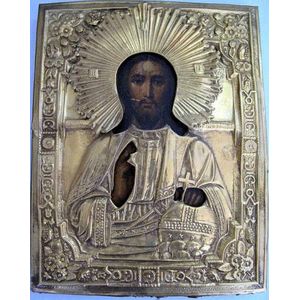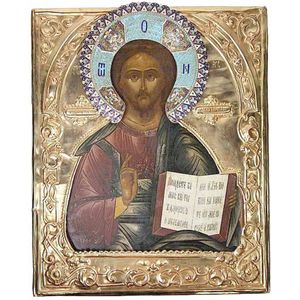Russian Icon of Christ Pantokrator with Enamelled Halo
You must be a subscriber, and be logged in to view price and dealer details.
Subscribe Now to view actual auction price for this item
When you subscribe, you have the option of setting the currency in which to display prices to $Au, $US, $NZ or Stg.
- Gilding - Gilding is a method of ornamentation whereby a thin sheet of gold metal is applied to items made of wood, leather, ceramics, glass and silver for decorative purposes.
For furniture including mirrors, the sheet of gold is usually applied over a coating of gesso. Gesso is a mixture of plaster of Paris and gypsum mixed with water and then applied to the carved wooden frames of mirrors and picture frames as a base for applying the gold leaf. After numerous coats of gesso have been applied, allowed to dry and then sanded a coat of "bole", a usually red coloured mixture of clay and glue is brushed on and allowed to dry, after which the gold leaf is applied. Over time parts of the gilding will rub off so the base colour can be seen. In water gilding, this was generally a blue colour, while in oil gilding, the under layer was often yellow. In Victorian times, gilders frequently used red as a pigment beneath the gold leaf.
Metal was often gilded by a process known as fire gilding. Gold mixed with mercury was applied and heated, causing the mercury to evaporate, the long-term effect of which was to kill or disable the craftsman or woman from mercury poisoning. The pursuit of beauty has claimed many victims, not the least of which were the artists who made those pieces so highly sought after today. - Ormolu - Ormolu was popular with French craftsmen in the 18th and 19th century for ornamental fittings for furniture, clocks and other decorative items. True ormolu is gilt bronze, that is bronze that has been coated with gold using a mercury amalgam. Due to the health risks associated with using mercury, this method of creating ormolu was discontinued in France in the 1830s. A substitute was developed consisting of about 75% copper and 25% zinc, however it was inferior to the bronze version. It was often lacquered to prevent it tarnishing.
This item has been included into following indexes:
Visually similar items

A c.1900 Russian icon, hand painted on board with 'Our Lady of Kazan & Child', traditional silvered and enamelled oklads with repousse work, the halos with enamelled detail on gilt metal, two enamelled plaques to the top. 31 cm x 25.5 cm

Russian icon of the mother of God of Kazan tempera on wood cover with gilded bronze, ormolu oklad, overlaid with magnificent embroidered beaded riza decorated with pearls and three stars embellishing her robe and headress. Champleve solid silver and enamel

Antique Orthodox Christian icon, 31 x 26 cm

Fine antique Russian icon gilt metal oklad Christ, the timber panel finely painted with Christ the the Pantokrator, his hand resting on a Sphairos, a ball that represents the cosmos, with repousse and hand engraved gilt metal oklad with borders of flowers
